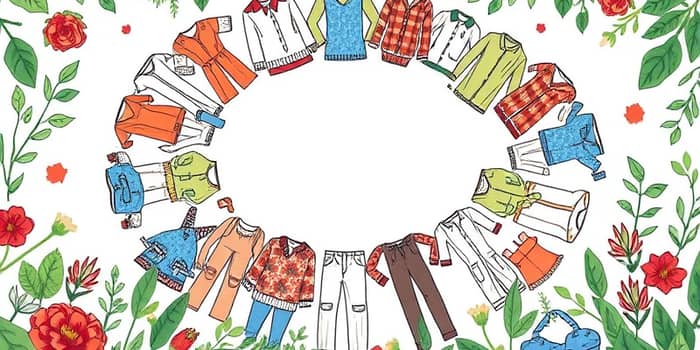Every season, countless garments end up in landfills, forgotten and unworn. The fashion industry churns out trends in a relentless “take-make-dispose” cycle, burdening the planet and overwhelming personal closets with items that serve little purpose beyond a fleeting moment of novelty. It’s time to challenge the status quo and rethink how we value our wardrobes.
By adopting a transforming consumption into long-term stewardship mindset, you can turn your closet into a thriving, sustainable ecosystem. A circular closet not only reflects your personal style but also helps safeguard resources and reduce waste.
The Problem with Fast Fashion
Fast fashion has made trendy clothing accessible and affordable, but at a steep environmental cost. The textile industry produces over 92 million tonnes of waste every year, while less than 12% of materials are recycled globally. Garment utilization has dropped by 36% in the last decade and a half, meaning you likely wear many pieces far less than you intend.
These inefficiencies contribute to pollution, resource depletion, and a throwaway culture that values quantity over quality. It’s time to break free from these harmful patterns and embrace alternatives designed for longevity and responsible use.
What Is a Circular Closet?
A circular closet is built on principles inspired by natural ecosystems, where nothing is wasted and every resource flows seamlessly back into the cycle. Rather than discarding items after a few wears, this approach emphasizes repairs, repurposing, and mindful consumption.
It stands in stark contrast to the linear model of consumption. By prioritizing the minimization of textile waste and encouraging resourceful habits, a circular wardrobe extends the life of each garment and reduces demand for virgin materials.
Principles and Practical Strategies
Transforming your closet requires conscious decisions at every stage, from purchase to end of life. Here are five core strategies:
- Rethinking Purchases: Buy Less, Buy Better Invest in high-quality garments made to last—timeless silhouettes, durable fabrics, and transparent brand practices.
- Prolonging Garment Life through Care and Repair Gentle washing, proper storage, and prompt mending keep items looking fresh. Learn basic sewing or find a local tailor to handle alterations.
- Embracing Secondhand and Sharing Shop consignment stores, join clothing swaps, or borrow for special events. This building community through clothing swaps reduces waste and fosters connections.
- Upcycling and Responsible Recycling Turn worn-out pieces into new creations—tote bags from shirts, shorts from old jeans—or use retailer take-back programs for safe recycling.
- Mindful Decluttering When letting go, opt for donation, resale, or specialized recycling. Avoid sending items to landfills whenever possible.
By weaving these strategies into your routine, you become an active participant in the circular economy, ensuring every piece serves its maximum purpose.
Industry Innovations Driving Change
More brands are recognizing the urgency of circularity, redesigning products and services to support extended lifecycles. From modular sneakers that can be disassembled to recycled-fiber sweaters and in-store take-back initiatives, these innovations demonstrate a path forward.
These figures highlight both the scale of the challenge and the immense opportunity for improvement. As more companies adopt circular design—mono-material garments, repair-friendly construction, and clear end-of-life plans—the entire system shifts toward sustainability.
Overcoming Challenges on Your Circular Journey
Transitioning to a circular closet isn’t without hurdles. Blended fabrics can be difficult to recycle, and not all resale or recycling programs operate effectively. Avoid “wishcycling”—donating unusable textiles—and research local drop-off points to ensure responsible processing.
Transparency in supply chains remains limited, and scaling circular solutions requires collaboration among brands, policymakers, and consumers. Yet every individual choice helps drive market demand for more ethical practices.
Taking Action: First Steps Towards Circularity
Your journey toward a sustainable wardrobe begins at home. Here’s how to get started right now:
- Audit your closet by categorizing items you wear regularly versus those you leave untouched.
- Implement a one-in, one-out rule to curb impulse buys and maintain balance.
- Learn basic sewing techniques to handle minor repairs and avoid premature disposal.
- Explore secondhand marketplaces, local swaps, and clothing rental services.
Over time, these small adjustments foster a deeper awareness of your consumption habits and build confidence in making intentional style choices.
Conclusion: The Future of Your Closet and the Planet
Shifting from a linear to a circular wardrobe is more than a practical change—it’s an unwavering commitment to sustainability and an opportunity to express values through personal style. Every repair, swap, and mindful purchase contributes to healthier ecosystems and stronger communities.
By embracing circular principles, we redefine ownership as stewardship, ensuring garments remain in use and out of landfills. Your closet truly deserves better: a future where fashion and environment flourish hand in hand.
References
- https://lifestyle.sustainability-directory.com/term/circular-wardrobe-economy/
- https://lifestyle.sustainability-directory.com/term/circular-wardrobe/
- https://www.lefashionpost.com/2025/02/17/how-circular-fashion-is-revolutionizing-your-wardrobe-and-the-planet/
- https://www.bluesign.com/en/circular-fashion/
- https://goodonyou.eco/what-is-circular-fashion/
- https://www.quitalks.show/post/a-slow-fashion-closet-building-a-sustainable-and-personal-wardrobe
- https://perell.com/essay/the-ultimate-guide-to-writing-online/
- https://bienalclosets.com/free-standing-closet-systems










